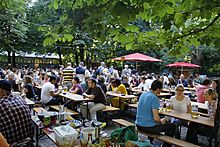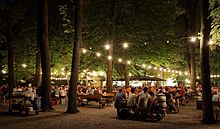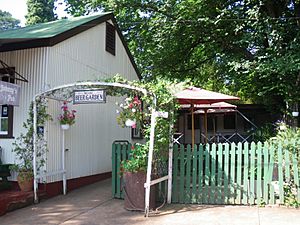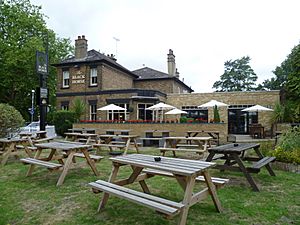Beer garden facts for kids
A beer garden (called Biergarten in German) is an outdoor place where people can enjoy food and drinks, often at shared tables under the shade of trees. These friendly spots are popular for gathering with family and friends.
Beer gardens first started in Bavaria, a region in Germany, during the 1800s. Munich is the capital city of Bavaria, and beer gardens are still very common there. They are usually connected to a brewery (a place that makes beer), a beer hall, a pub, or a restaurant.
Contents
History of Beer Gardens
Places similar to beer gardens existed in Germany even before the 1800s. For example, in Bamberg, there were "Beer cellars" (Bierkeller) as early as 1605. However, the first true "Biergarten" as we know it today, following a special rule from 1812, began in Munich. We don't know exactly which brewery started it, but it was likely one of Munich's famous ones, like Löwenbräu or Hofbräuhaus.
Long ago, there were rules about when beer could be made. In 1553, a rule said beer could only be brewed from late September to late April. This was because brewing beer involved boiling, which could cause fires, especially in warm weather. To keep beer cool during storage, large breweries dug cellars into riverbanks. These "beer cellars" soon became places where people could also drink beer.
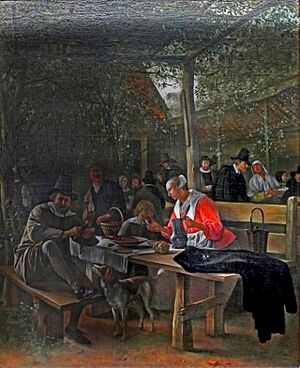
To keep these cellars even cooler in summer, brewers covered them with gravel. They also planted horse-chestnut trees because these trees have wide, shady tops and roots that don't damage the cellars. Soon, people realized that serving cool beer under these shady trees was a great idea. Simple tables and benches were set up, creating the first beer gardens.
At first, only beer was served. But then, food started to be offered. Smaller breweries worried they couldn't compete. So, as a compromise, beer gardens allowed people to bring their own food. This is still a common practice today! If you bring your own food, you usually sit at tables without tablecloths. If you buy food from the beer garden, you sit at tables with tablecloths. Beer gardens became even more popular when new ways of making beer (called lager) were invented later in the 1800s.
Today, many beer gardens do not allow outside food. They often serve traditional Bavarian dishes. These include Radi (radish), Brezn (soft pretzel), Obatzda (a cheese dip), halbes Hendl (half a grilled chicken), Hax'n (pork knuckle), and Steckerlfisch (grilled fish). A key part of the beer garden experience is Gemütlichkeit. This German word means a feeling of warmth, friendliness, and belonging. People often share tables, listen to music, sing, and enjoy each other's company.
In 1999, Bavaria even made a special rule about beer gardens. It allows traditional beer gardens with shady trees, where people can bring their own food, to stay open later and be a bit noisier. This shows how important they are to the culture. Some people distinguish between a Wirtsgarten, which only sells its own food, and a true Biergarten, where you can bring your own.
Beer Gardens Around the World
The term "beer garden" is now used for many outdoor places where beer is served. While traditional ones have trees, wooden benches, and fresh meals, modern ones might have plastic chairs or fast food.
The largest traditional beer garden in the world is the Hirschgarten in Munich, Germany. It can seat 8,000 people!
Australia
Australia has many beer gardens. They are usually part of a pub or next to sports fields.
Austria
In Austria, beer gardens are called Gastgarten, which means "guest garden." They serve food like ein Paar Würstel (a pair of sausages) or Schweinebraten (pot-roasted pork). When ordering beer, you can choose different sizes, like a Pfiff (0.2 liter) or a Krügerl (0.5 liter).
Canada
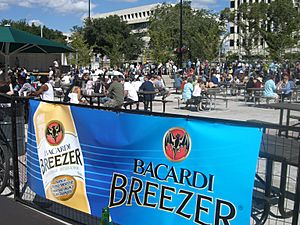
Canada traditionally didn't have many outdoor eating places like beer gardens. This was partly due to cold weather and insects. However, outdoor cafes and restaurant patios became more common in cities. These are usually attached to places that have a license to serve drinks.
Canadian laws generally don't allow drinking in public places without a license. But in recent years, some areas have become more relaxed. In Canada, beer gardens are often special areas at events like concerts or festivals. They can be outdoors or indoors, depending on the season. They are very popular at big sporting events. Even though they are called "beer gardens," most also serve other drinks. It's usually against the rules to take drinks out of the area or bring your own drinks in.
Germany
Beer gardens are still very popular in Germany. The Hirschgarten restaurant in Munich has one of the largest beer gardens in the world, with space for over 8,000 people. It has been around since 1791.
In 2011, Berlin set a world record for the longest beer garden. It was part of the Berlin Beer Festival and measured 1,820 meters (about 1.1 miles) long!
Japan
Beer gardens are popular in Japan too. Many of them are found on the rooftops of department stores and hotels.
United Kingdom
In Britain, a beer garden is an open area connected to a pub. In the countryside, they often have nice views. In towns and cities, they are usually open garden spaces. Pubs along canals often have beer gardens right by the water. Many pubs compete to be named 'Britain's best beer garden'. Some offer outdoor music, along with food and drinks.
United States
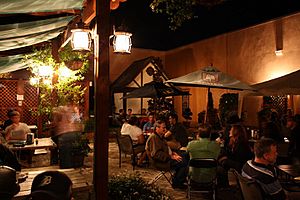
In the United States, beer gardens historically offered more than just drinks. Some had shooting galleries, bowling alleys, and live music. People could go for entertainment even if they didn't want to drink. Today, many beer gardens have outdoor games or board games for people to play.
The Raleigh Beer Garden in Raleigh, North Carolina, holds a world record. It has the largest selection of beer at one place, with 378 different beers on tap.
Laws about serving drinks in the U.S. vary by state. For example, in Washington state, organizers need a special license. Drinks can only be consumed in a fenced-off area. There are also rules about signs related to drinks at these events.
See also
 In Spanish: Biergarten para niños
In Spanish: Biergarten para niños


